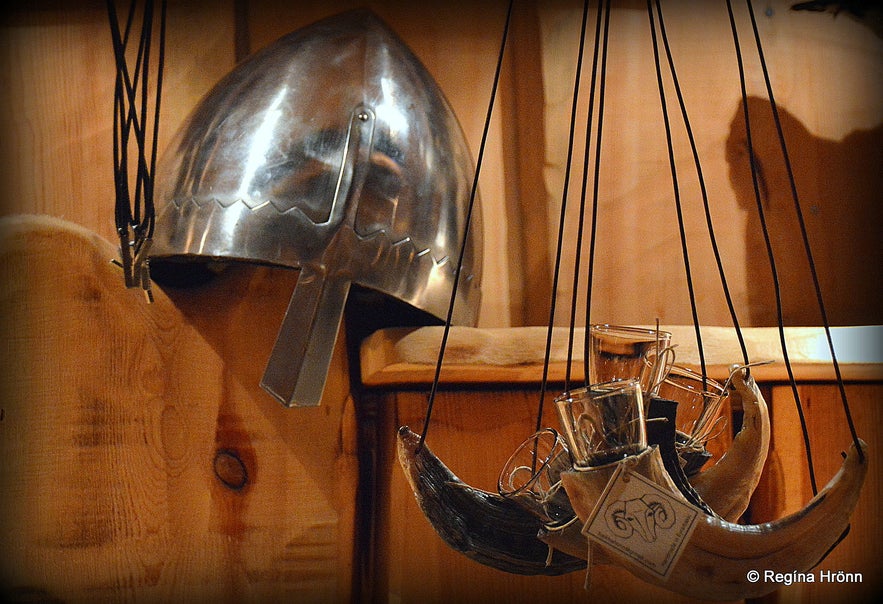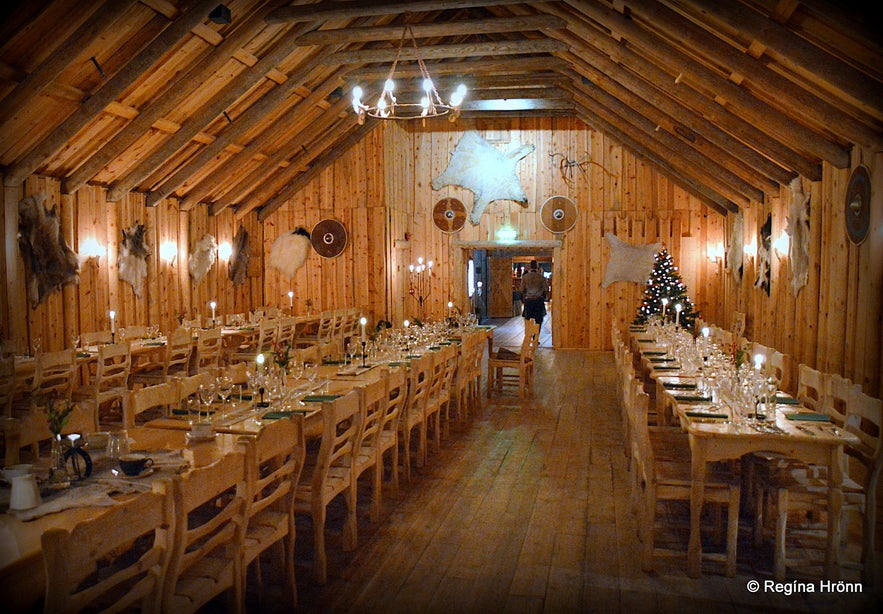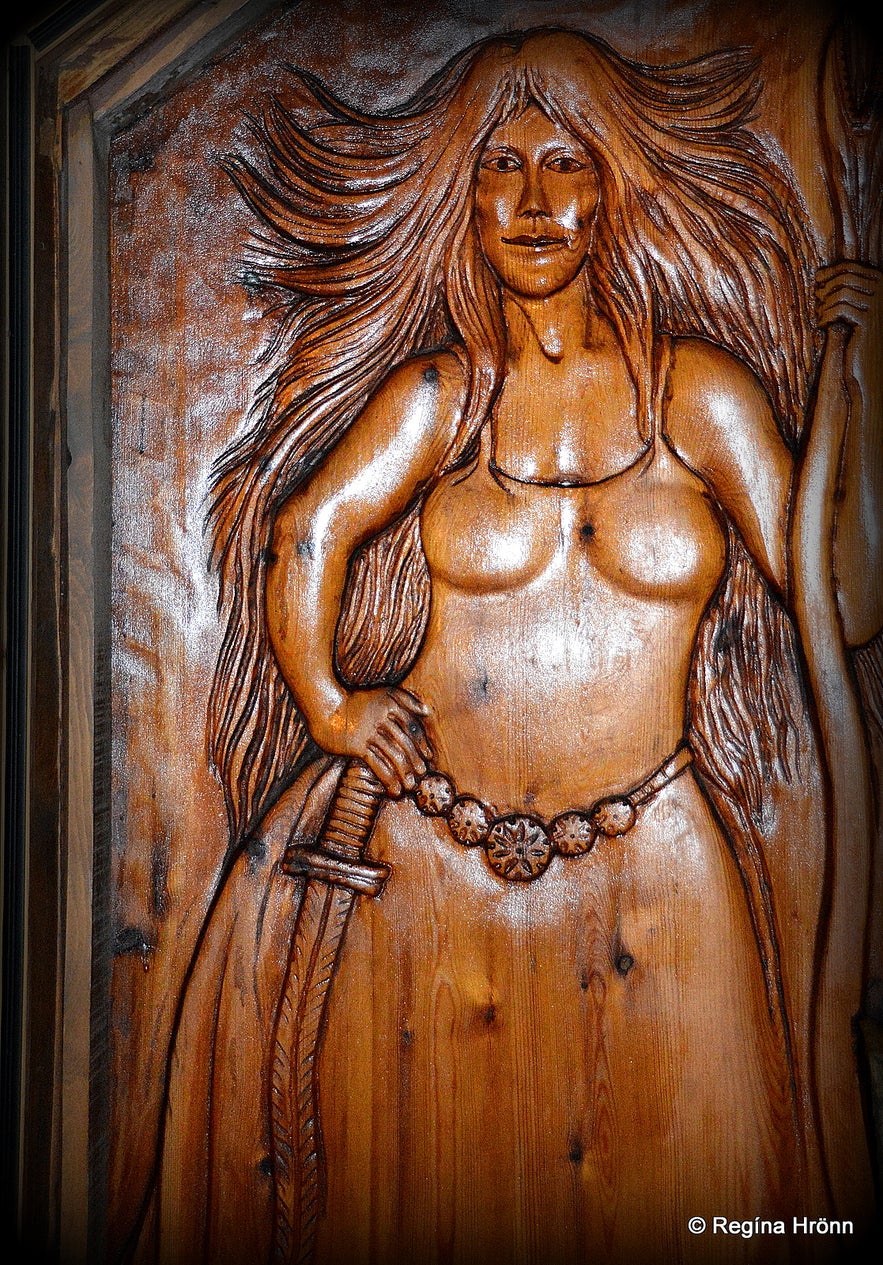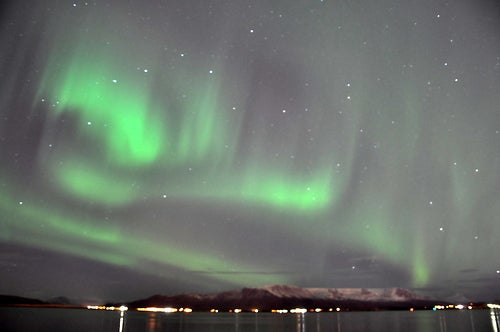
As those of you, who read my travel-blog know, then I love writing about turf houses, folklore, and the Icelandic Vikings.
I recently visited a replica of a Viking turf longhouse erected in honour of Iceland's first settler, Ingólfur Arnarson (844). It is most fittingly called Ingólfsskáli longhouse.
In another travel-blog, I told you about the Norwegian settlers Ingólfur and his blood-brother, brother-in-law, and second cousin Hjörleifur, who arrived in Iceland together with their wives, Hallveig and Helga, in their Viking ships around the year 874.
Top photo: Ingólfsskáli in South Iceland

Ingólfur and his wife Hallveig - as depicted at the Saga Museum in Reykjavík, which I recommend visiting
When they had spotted Iceland their ships separated. Ingólfur stayed for the first winter at Ingólfshöfði promontory in southeast Iceland and Hjörleifur at Hjörleifshöfði promontory in South Iceland.
A description of Ingólfur can be found in Landnáma - the Book of Settlements in Iceland. It was written in the 12th century and the story of Ingólfur and Hjörleifur is found in chapters 3-9.

Hjörleifshaugur burial mound on top of Hjörleifshöfði cape
I dedicated the travel-blog Hjörleifshöfði Promontory in South Iceland - the Blood Brothers Ingólfur and Hjörleifur to the blood brothers and the ill fate of Hjörleifur, whose burial mound is believed to be on top of Hjörleifshöfði.
Hjörleifur was killed by his Irish slaves, who then fled to the Westman Islands and were hunted down and killed by Ingólfur.
In that travel-blog, you will get a much more detailed description of what happened before Ingólfur stayed for the third winter by Mt. Ingólfsfjall.

A carving of the Viking Ingólfur on the front door of Ingólfsskáli by Erlendur F. Magnússon
The next winter after revenging the killing of his blood brother, Ingólfur stayed at Hjörleifshöfði.
The third winter he stayed by Mt. Ingólfsfjall.
Ingólfur is believed to have stayed by the southeast corner of Mt. Ingólfsfjall in South Iceland by Fjallstún, but Ingólfsskáli Viking longhouse stands by the west side of the mountain.

Mt. Ingólfsfjall and Silfurberg
Mt. Ingólfsfjall is around 8 km long and 5 km wide table mountain, with the highest peak, Inghóll, rising some 551 meters in the air.
The mountain is named after Ingólfur and his burial mound is believed to be on the top of Mt. Ingólfsfjall.
The story goes that he chose this location so that he could see his first settlement. And that his dog is buried in a smaller mound.
There is also a spot in the middle of Reykjavík where Ingólfur Arnarson is believed to have been buried, so we don't know for sure, but it is fun to speculate.

Silfurberg
During the Ice age, the sea reached up to 60 meters of the mountainside of Ingólfsfjall. Thus the flat land in this area is an ancient seabed.
You see the different-looking grey rocks in the mountain called Silfurberg. The grey rocks are tuff, and were created through a particular geological procedure, way too complicated for me, who am just a layman, to understand ;)
In the tuff, you will see sparkling zeolite.

Hiking on Silfurberg
I hiked up to Silfurberg as I wanted to see it up close and touch the stones. We had driven past Silfurberg for decades always talking about how we must see it up close and touch it.
Finally in 2020 during the pandemic when we couldn't travel anywhere out of the country, we hiked up Silfurberg on a beautiful and sunny April day.
It is a lovely and easy hike on which you will see many strange rock formations, some of which resemble prehistoric creatures, in my opinion.

Prehistoric-looking rock formations at Silfurberg
We took our time and spent 1.5 hiking on Silfurberg.
This Silfurberg, is not to be mistaken for the Iceland spar silfurberg, which bears the same Icelandic name.
Helgustaðanáma mine in East Iceland is the best-known Icelandic spar mine, which used to be a valuable export for Icelanders.

Kögunarhóll hill
South of Mt. Ingólfsfjall, on the other side of ring-road 1, you will find a small tuff hill, called Kögunarhóll also Knarrarhóll - knarr meaning a vessel.
Some say that Ingólfur's Viking ship was buried inside the hill.
Before the new road was constructed you couldn't miss this hill as in front of it by the road, 52 white crosses were erected in memory of the people who have been killed in traffic accidents on Suðurlandsvegur - the south region road number 1.
Now the crosses have been removed and you can park your car close to Kögunarhóll hill and hike to the top.

A Viking helmet and drinking horns at Ingólfsskáli
If you carry on driving towards Selfoss town you will see a big scar in the Mt. Ingólfsfjall by Þórustaðanáma quarry.
But we are going to visit Ingólfsskáli longhouse so we turn left before we reach Mt. Ingólfsfjall.
Mt. Ingólfsfjall has been known to tremble and in 2008 the epicenter of the Suðurlandsskjálftinn earthquake was right beneath Mt. Ingólfsfjall.
The earthquake was a doublet earthquake with a 3-second interval, of a magnitude of 6.3 on the Richter scale.

A rock outside Ingólfsskáli
One of the earthquakes was extremely close to Ingólfsskáli longhouse on the west side of Mt. Ingólfsfjall and a crack can be seen in Kögunarhóll hill.
The other one shook the earth some 5 km west of Mt. Ingólfsfjall, so the Ingólfsskáli longhouse trembled from both directions.
The previous 2 big earthquakes in the southern region happened in June 2000.
We Icelanders dread this Southern region earthquake. My grandparents used to talk about it every time we drove by Mt. Ingólfsfjall and that now the earthquake was due and pointed to the big rocks in the mountain slopes, scaring the living daylights out of their grandchildren.

Ingólfsskáli
My grandfather experienced one big earthquake, 7.0 on the Richter scale in South Iceland, when he was 2 years old back in 1912.
The earthquakes happen at around a 70-year interval or so, and we are not expecting another one for a while.
But we live on the tectonic plates on a volcanic island, so everything can happen. And, in February-March 2021 the SW-corner experienced a whole lot of tremors and a volcanic eruption started, which was quite unexpected and gave us who live on the southwest corner quite a scare.

Boulders came tumbling down Mt. Ingólfsfjall
It so happened though that on the 29th of May, 2008 I was running after my bus in Reykjavík when the earthquake hit us and didn't feel it, just felt some dizziness.
So I only heard about the Suðurlandsskjálftinn earthquake when I heard people talking about it on my bus. And I who had been dreading this earthquake since I was a little girl!
In the photo above taken on the southeast side of Mt. Ingólfsfjall, you can see the huge rocks which have come tumbling down the mountain in these earthquakes.

The earthquake exhibition in Hveragerði
The southern region was hit hard with the houses in the area suffering damage, but fortunately no fatalities.
You can visit an exhibition in Hveragerði town on the earthquake in 2008, and see what the inhabitants of this area have to say about their experience of the earth shaking violently.
You can also try out an earthquake simulator at the exhibition for a small fee. The exhibition is located in the shopping complex Sunnumörk.
During the construction work of the shopping complex, a crack appeared. This area is after all situated on the tectonic plates, which is why we have big earthquakes here.

My little niece looking into the rift in the floor in September 2008 at Hveragerði library
The crack goes straight through the Hveragerði library and parts of it can be found in the earthquake exhibition.
The earthquake crack was covered by glass and lit up. You can visit the library and earthquake exhibition and check it out.
On one side you will be in North America and on the other side you will find yourself in Europe, as it were.
Ingólfsskáli longhouse was hit hard by the earthquake and suffered great structural damage.

Ingólfsskáli
You can see some of the damages in the earthquake in this Mbl. article. "Our life's work is ruined", Svava Gunnarsdóttir, farmer, says in the article.
Svava Gunnarsdóttir and Björn Kristjánsson built the longhouse, Ingólfsskáli, themselves, which is not a small task and very expensive to build.
When you visit Ingólfsskáli you will see how huge it is on the inside - I thought to myself when I saw how well-made it is, that my hometown, Reykjavík, should have built such a longhouse in honour of the first settler in Reykjavík.
Kudos to the farmers by Mt. Ingólfsfjall for taking on such a huge private enterprise!

Pelts and Viking shields decorate the walls of Ingólfsskáli - they have even got a polar bear
When I visited Ingólfsskáli the owner showed me how some of the doors reach around 30-40 cm below the floor surface. And the full length of the floor got lifted as the earth beneath it moved.
He told me that the floor looked like corrugated cardboard!
The earthquake was so powerful that the massive rafters broke like toothpicks! If you look up and watch closely then you will see that some of the rafters in the middle of Ingólfsskáli had to be rebuilt - they were fortified with iron, so they are very secure now.
Fortunately, Ingólfsskáli survived but had to be repaired and fortified. It would have been a great loss if it had been torn down.

Beautiful carvings in Ingólfsskáli
I am in love with the Viking longhouses in Iceland and there are way too few such structures.
Also, check out:
Stöng - Ruins of a Real Viking Settlement Manor and the Reconstructed Saga-Age Farm in Iceland
I have also written a travel-blog about Viking Ruins I have visited on my Travels in Iceland - which is a list of all the archaeological sites and burial mounds, which I have visited in Iceland.
The farm, Efstaland, suffered great damage as well. Fortunately, the National Catastrophe Insurance of Iceland back then called Viðlagatryggingasjóður Íslands helped out the sufferers of the earthquake.
My best friend was working for that company when the earthquake happened and the workload was massive and there was no summer vacation for her that year.

The way it all started:
In 1984 when having had to battle with hayfever for years, the farmer Björn Kristjánsson at Efstaland farm decided that he needed to start a new line of work. As farming and hayfever don't quite match.
So the barn and cowshed had to be put into better use and were transformed into a restaurant, which Björn and his wife Svava Gunnarsdóttir, named Básinn - the Stall.
The replica of a Viking longhouse was then erected in 1998 and named Ingólfsskáli after Ingólfur Arnarson, Iceland's first settler. It wasn't a farfetched idea naming the Viking longhouse after Ingólfur seeing that the farmers had lived by Mt. Ingólfsfjall their whole adult life.

Turf walls at the entrance of Ingólfsskáli
The cement walls of Ingólfsskáli are timber paneled, but the outer walls are made of turf and the roof is covered with grass.
You can see in my photo above how the turf by the entrance of Ingólfsskáli is stacked to get the best insulation. The Vikings knew that good insulation in this cold country was vital for surviving the long winters.
The Viking longhouse, Ingólfsskáli, is huge, with room for more than 400 people. I had only seen it from the outside as the restaurant was for groups only, but they recently changed that and Ingólfsskáli is open for individual guests as well at night on weekdays.

Visiting Ingólfsskáli
So I was thrilled to be finally able to visit it and booked a table for their Christmas buffet.
They offer fresh Icelandic food from Icelandic nature and emphasis is put on sustainability and products from the surrounding areas.
F.ex. trout and salmon which they catch in the Icelandic rivers, geese, and reindeer, which roam free in southeast and East Iceland. Other produce they get from the farms in the vicinity.

The buffet at Ingólfsskáli
Gunnar Björnsson, the eldest son of the farmers Björn and Svava, now runs the restaurant together with his wife and son, Andri. And on a good day, 4 generations of family members help out at this lovely family-run Viking restaurant.
Ingólfsskáli offers a Viking dinner experience all year round:
Viking Dinner Experience | 4-Course Meal with a Taste of History
The Viking dinner experience includes a four-course meal, a bottle of Icelandic mead, a shot of Icelandic Schnapps, and a guided tour of Ingólfsskáli. You will get to drink from a Viking horn and eat with cutlery forged in fire.

Photo courtesy of Ingólfsskáli
Ingólfsskáli allowed me to use one of their photos to show you the employees dressed in clothes from the Viking era.
The woodwork at Ingólfsskáli was beautifully carved by a local from Hveragerði town, Erlendur F. Magnússon.
All the wooden chairs were carved by him by hand and the carvings of Óðinn by the bar. The beautiful carvings on the front door show the Vikings Ingólfur and Hallveig.

Beautifully carved doors in Ingólfsskáli
Another well-known family-run Viking restaurant can be found in Hafnarfjörður in the Great Reykjavík Area - Fjörukráin at the Viking Village, which I visit often with my guests.
In my opinion, there aren't enough Viking activities in Iceland, so I am glad that there are at least 2 Viking restaurants to choose from :)
See also: The Icelandic Vikings - a List of Viking Activities in Iceland today

Ingólfur Arnarson as depicted at the Saga Museum
Now back to Ingólfur the first settler of Iceland - what happened to him after he stayed at Mt. Ingólfsfjall?
After having stayed at Mt. Ingólfsfjall the slaves of Ingólfur finally found his high seat pillars, which he had thrown in the sea from his Viking ship on spotting Iceland.
Ingólfur had pledged to settle where the high seat pillars would land as that would be the place the gods had chosen for him. This search then took some 3 winters.

The high seat pillars at Ingólfstorg square in the old centre of Reykjavík
The high seat pillars landed in southwest Iceland by Arnarhvoll, where you will now find Reykjavík, the capital city of Iceland.
Ingólfur named this place Reykjarvík - Smoke Cove as he saw smoke - steam - rising from geothermal water in the ground.
You will find 2 high seat pillars made of basalt columns on Ingólfstorg square by Reykjavík's oldest street, Aðalstræti.
Photo taken at the Settlement Exhibition 871 ± 2
Ingólfur's settlement land was big, all the way from Ölfusá river in the east to Hvalfjörður in the west.
Remains of a longhouse from the Viking Settlement age were discovered in Aðalstræti street. They might be the remains of Ingólfur's settlement farm.
A museum was built around the remains and you can visit them at the Settlement Exhibition 871 ± 2.

The statue of Ingólfur Arnarson at Arnarhóll in Reykjavík - some prankster put lipstick on it
A statue of Ingólfur Arnarson was erected in 1924 on Arnarhóll hill in the centre of Reykjavík, where he watches his homestead turning into a fast-growing city. So much so that he cannot even see the harbour anymore.
The statue was made by my favourite Icelandic sculptor Einar Jónsson.
It shows Ingólfur standing tall holding a halberd leaning against the head of a dragon. You might notice that his helmet has no horns, as was the case with Viking helmets.
And only the wealthier Vikings could afford to own a Viking helmet made of metal.
A cast of Ingólfur's statue was erected in 1961 at Rivedal in Norway, his old home.

Ingólfur's statue on Arnarhóll in Reykjavík
Ingólfsskáli longhouse is located by Efstaland farm in Ölfus in South Iceland, midway between the towns Hveragerði and Selfoss. To visit Ingólfsskáli you can rent a car in Reykjavík - the drive from Reykjavík is around 53 km.
Pass Hveragerði town and turn left from ring road 1 onto road 374 before you reach Mt. Ingólfsfjall. You will see a sign by the road. Drive for some 3 km and you will have reached Ingólfsskáli.
Here is the exact location of Ingólfsskáli on Google maps.

By one of the beautifully carved doors of Ingólfsskáli
If you carry on driving east on ring-road 1 and take the next left turn you will find yourself on the most popular circle in Iceland - the Golden Circle.
For further reading:
Hjörleifshöfði Promontory in South Iceland - the Blood Brothers Ingólfur and Hjörleifur
Hjörleifshöfði Promontory in South Iceland - the Hike and the Inhabitant
The settlers Ingólfur and Hallveig were my ancestors 30 generations back.
Have a lovely time in South Iceland :)
Sources:














